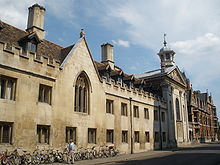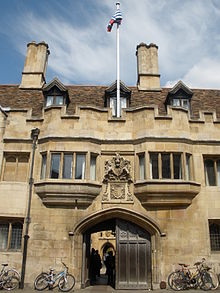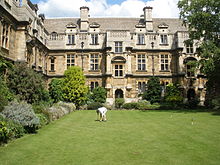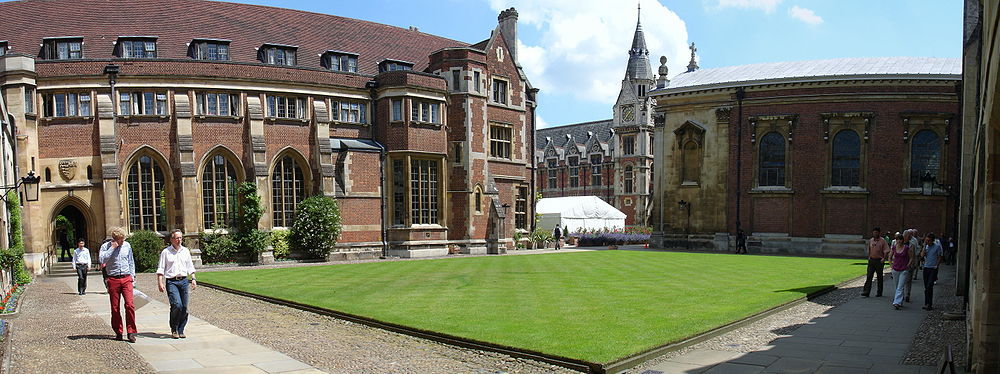
Pembroke College, Cambridge
Background Information
The articles in this Schools selection have been arranged by curriculum topic thanks to SOS Children volunteers. SOS Child sponsorship is cool!
| Colleges of the University of Cambridge Pembroke College |
||||||||||||
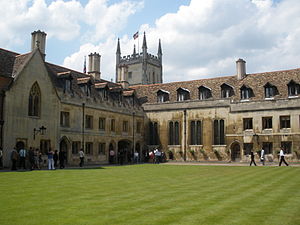 |
||||||||||||
|
|
||||||||||||
| Founder | Marie de St Pol, Countess of Pembroke | |||||||||||
| Established | 1347 | |||||||||||
| Previously named | Marie Valence Hall (1347-?) Pembroke Hall (?–1856) |
|||||||||||
| Admission | Men and women | |||||||||||
| Master | Sir Richard Dearlove | |||||||||||
| Undergraduates | 442 | |||||||||||
| Graduates | 264 | |||||||||||
| Sister college | Queen's College, Oxford | |||||||||||
| Location | Trumpington Street ( map) | |||||||||||
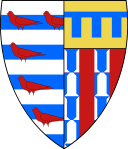 |
||||||||||||
| College website | ||||||||||||
| Boat Club website | ||||||||||||
Pembroke College is a constituent college of the University of Cambridge, England.
The college has over seven hundred students and fellows, and is the third oldest college of the university. Physically, it is one of the university's larger colleges, with buildings from almost every century since its founding, as well as extensive and immaculately maintained gardens. The college is a financially well-to-do institution, with an endowment of £53.3 million as of 2012, which places it around the middle in the list of the university colleges. Pembroke has a level of academic performance among the highest of all the Cambridge colleges, with an average rank of 6.7 out of 29 in the unofficial Tompkins Table.
Pembroke College is home to the first chapel designed by Sir Christopher Wren and is also one of the Cambridge colleges to have educated a British prime minister, William Pitt the Younger. The college library, one of the finest in the university, with a Victorian neo-gothic clock tower, is endowed with an original copy of the first encyclopaedia to contain printed diagrams. The college's current master, Sir Richard Dearlove, was previously the head of the United Kingdom's Secret Intelligence Service.
History
On Christmas Eve 1347, Edward III granted Marie de St Pol, widow of the Earl of Pembroke, the licence for the foundation of a new educational establishment in the young university at Cambridge. The Hall of Valence Mary, as it was originally known, was thus founded to house a body of students and fellows.
The statutes were notable in that they both gave preference to students born in France who had already studied elsewhere in England, and that they required students to report fellow students if they indulged in excessive drinking or visited disreputable houses.
The college was later renamed Pembroke Hall, and finally became Pembroke College in 1856.
Buildings
The first buildings comprised a single court (now called Old Court) containing all the component parts of a college — chapel, hall, kitchen and buttery, master's lodgings, students' rooms — and the statutes provided for a manciple, a cook, a barber and a laundress. Both the founding of the college and the building of the city's first college Chapel (1355) required the grant of a papal bull.
The original court was the university's smallest at only 95 feet (29 m) by 55 feet (17 m), but was enlarged to its current size in the nineteenth century by demolishing the south range.
The college's gatehouse, however, is original and is the oldest in Cambridge. The Hall was rebuilt in 1875–6 by Alfred Waterhouse after he had declared the medieval Hall unsafe.
The original Chapel now forms the Old Library and has a striking seventeenth century plaster ceiling, designed by Henry Doogood, showing birds flying overhead. Around the Civil War, one of Pembroke's fellows and Chaplain to the future Charles I, Matthew Wren, was imprisoned by Oliver Cromwell. On his release after eighteen years he fulfilled a promise by hiring his nephew Christopher Wren to build a great Chapel in his former college. The resulting Chapel was consecrated on St Matthew's Day, 1665, and the eastern end was extended by George Gilbert Scott in 1880, when it was consecrated on the Feast of the Annunciation.
An increase in membership over the last 150 years saw a corresponding increase in building activity. As well as the Hall, Waterhouse built a new range of rooms, Red Buildings (1871–2), in French Renaissance style, designed a new Master's Lodge on the site of Paschal Yard (1873, later to become N staircase), pulled down the old Lodge and the south range of Old Court to open a vista to the Chapel, and finally built a new Library (1877–8) in the continental Gothic style.
Waterhouse was dismissed as architect in 1878 and succeeded by George Gilbert Scott, who, after extending the Chapel, provided additional accommodation with the construction of New Court in 1881, with letters on a series of shields along the string course above the first floor spelling out the Psalm text "Nisi Dominus aedificat domum…" ("Except the Lord build the house, their labour is but vain that build it").
Building work continued into the 20th century with W. D. Caröe as architect. He added Pitt Building (M staircase) between Ivy Court and Waterhouse's Lodge, and extended New Court with the construction of O staircase on the other side of the Lodge. He linked his two buildings with an arched stone screen, Caröe Bridge, along Pembroke Street in a late Baroque style, the principal function of which was to act as a bridge by which undergraduates might cross the Master's forecourt at first-floor level from Pitt Building to New Court without leaving the College or trespassing in what was then the Fellows' Garden.
In 1926, as the Fellows had become increasingly disenchanted with Waterhouse's Hall, Maurice Webb was brought in to remove the open roof, put in a flat ceiling and add two storeys of sets above. The wall between the Hall and the Fellows' Parlour was taken down, and the latter made into a High Table dais. A new Senior Parlour was then created on the ground floor of Hitcham Building. The remodelling work was completed in 1949 when Murrary Easton replaced the Gothic tracery of the windows with a simpler design in the style of the medieval Hall.
In 1933 Maurice Webb built a new Master's Lodge in the south-east corner of the College gardens, on land acquired from Peterhouse in 1861. Following the war, further accommodation was created with the construction in 1957 of Orchard Building, so called because it stands on part of the Foundress's orchard. Finally, in a move to accommodate the majority of junior members on the College site rather than in hostels in the town, in the 1990s Eric Parry designed a new range of buildings on the site of the Master's Lodge, with a new Lodge at the west end. "Foundress Court" was opened in 1997 in celebration of the College's 650th Anniversary. In 2001 the Library was extended to the east and modified internally.
Pembroke's enclosed grounds also house some particularly well-kept gardens, sporting a huge array of carefully selected vegetation. Highlights include "The Orchard" (a patch of semi-wild ground in the centre of the college), an impressive row of Plane Trees and an immaculately kept bowling green, re-turfed in 1996, which is reputed to be among the oldest in continual use in Europe.
Pembroke today
Pembroke College has both graduate and undergraduate students, termed Valencians, after the College's original name. The undergraduate student body is represented by the Junior Parlour Committee (JPC). The graduate community is represented by the Graduate Parlour Committee (GPC). Pembroke is unusual in having its recreational rooms named as "parlours" rather than the more standard "combination room". There are many clubs and societies organised by the students of the college, such as the college's dramatic society the Pembroke Players, which has been made famous by alumni such as Peter Cook, Eric Idle, Tim Brooke-Taylor, Clive James and Bill Oddie and is now in its 50th year.
International programmes
Pembroke is the only Cambridge college to have an International Programmes Department, providing opportunities for international students to spend a semester (mid-January to mid-June), or part of the summer, in Cambridge.
The Semester Abroad Scheme is a highly competitive programme open to academically outstanding students who wish to follow a regular Cambridge degree course as fully matriculated members of the University. There are around thirty places each year.
In the summer there are three prestigious and dynamic programmes on offer: the Pembroke-King's Programme, the International Security and Intelligence Programme, and the Pembroke College-National Academy of Writing Summer Programme.
The Pembroke-King’s Programme (PKP) offers international students an exceptional opportunity to experience Cambridge student life over eight weeks, the length of a regular undergraduate term. Living in Pembroke or King’s Colleges, students choose three courses from the around forty-five on offer, including courses in the arts, social sciences, business and management, humanities and sciences. Courses are academically 'Cambridge' in style, content and standard. Trips are made to locales such as Edinburgh, Scotland, and the programme has a series of formal halls, which are described as "three-course candlelit meals" serving "interesting" fare in Pembroke's historic dining hall. The Pembroke-King's Programme is also the programme for which the prestigious Thouron Prize is awarded, fully supporting nine American undergraduates from Harvard, Yale, and UPenn.
The International Security and Intelligence Programme, co-chaired by Sir Richard Dearlove, former Head of the British Secret Intelligence Service and current Master of Pembroke College, and Professor Christopher Andrew, Emeritus Professor of Modern and Contemporary History and founder of the Intelligence Seminar at the University of Cambridge, offers a unique opportunity to work with leading practitioners and academics from the security and intelligence communities in an exploration of the ‘craft of intelligence’.
The Pembroke College-National Academy of Writing Summer Programme offers a unique opportunity for those with a commitment to developing their writing to meet and work with leading practitioners, over three intense weeks. This programme explores aspects of effective narrative writing, from the generation of ideas to methodologies for editing and is designed for those with at least some, and possibly quite an extensive, background in creative writing who are looking for inspiration from a course which is above all about the practice and art of writing.
Pembroke also works with a number of Japanese universities to provide academic programmes specifically designed for their students.
Catering
Although the food in Hall is affectionately known as "Trough," this is not necessarily an accurate description and catering at Pembroke is generally thought to be quite good. In particular, catering manager David Harwood received the Cambridge Catering Award in 2005 for his "outstanding quality and affordable prices". In 2007 the UK's first Vegan 'tapas' bar was opened, and in spring 2008 the students voted (by a large majority) for Pembroke to serve only free-range chicken (it will be the first UK college to do so). Also, since October 2008, freshly prepared sushi is available, as well as high quality soup, cheeses and cured meats. Pembroke is Cambridge's 2nd Fairtrade College (after St Catharine's), and is also committed to serving local produce and sustainable fish where possible.
Notable alumni of Pembroke College

|image=
| Name | Born | Died | Occupation |
|---|---|---|---|
| Lancelot Andrewes | 1555 | 1626 | Master, Dean of Westminster, Bishop of Chichester, Ely, Winchester |
| C.F. Andrews | 1871 | 1940 | Author and supporter of Indian Independence |
| David Armitage Bannerman | 1886 | 1979 | Ornithologist |
| John Bradford | 1510 | 1550 | Fellow, prebendary of St. Paul's, Martyr |
| Clive Betts | 1950 | British politician | |
| Tim Brooke-Taylor | 1940 | Comedian | |
| William Burkitt | 1650 | 1703 | New Testament commentator, Vicar & Lecturer of Dedham, Essex |
| Roger Bushell | 1910 | 1944 | Leader of "The Great Escape" |
| "RAB" Butler | 1902 | 1982 | British politician |
| Peter Cook | 1937 | 1995 | Comedian |
| Maurice Dobb | 1900 | 1976 | Economist |
| Ray Dolby | 1933 | Inventor | |
| Timothy Dudley-Smith | 1926 | Hymnwriter and clergyman of the Church of England | |
| Abba Eban | 1915 | 2002 | Statesman |
| Edward James Eliot | 1758 | 1797 | British politician |
| William Eliot | 1767 | 1845 | British politician |
| Archibald Fargus | 1878 | 1963 | Cricketer, scholar, clergyman |
| Femi Fani-Kayode | 1960 | Former Nigerian Minister of Culture and Tourism | |
| William Fowler | 1911 | 1995 | Nobel prize winner |
| Arthur Gilligan | 1894 | 1976 | England cricket captain |
| Alexander Grantham | 1899 | 1978 | Governor of Hong Kong |
| Thomas Gray | 1716 | 1771 | Poet |
| Stephen Greenblatt | 1943 | Literary critic, pioneer of New Historicism | |
| Rupert Gwynne | 1871 | 1924 | MP for Eastbourne 1910–1924. |
| Naomie Harris | 1976 | Actress | |
| Tom Harrisson | 1911 | 1976 | Ornithologist, anthropologist, soldier, co-founder of Mass-Observation Project |
| Samuel Harsnett | 1561 | 1631 | Master, Vice-Chancellor of the University of Cambridge, later Archbishop of York and theological writer |
| Oliver Heald | 1954 | British politician | |
| Ted Hughes | 1930 | 1998 | Poet |
| Eric Idle | 1943 | Entertainer, comedian, member of Monty Python | |
| Koyata Iwasaki | 1879 | 1945 | 4th President of the Mitsubishi Zaibatsu |
| Clive James | 1939 | Novelist | |
| Atma Jayaram | 1915 | 1990 | Former Director of the Indian Intelligence Bureau |
| Peter Jeffrey | 1929 | 1999 | Actor |
| Humphrey Jennings | 1907 | 1950 | Film-maker |
| Bryan Keith-Lucas | 1912 | 1996 | Political scientist |
| Emma Johnson | 1966 | Clarinetist | |
| Robert Macfarlane | 1976 | Writer | |
| David MacMyn | 1903 | 1978 | Rugby union international (Scotland and Lions) player and administrator |
| Sir Henry James Sumner Maine | 1822 | 1888 | Jurist and Historian |
| Peter May | 1929 | 1994 | Cricketer |
| D. H. Mellor | 1938 | Philosopher | |
| Tom Morris | 1964 | Theatre director and producer | |
| David Munrow | 1942 | 1976 | Musician, composer, music historian |
| Richard Murdoch | 1907 | 1990 | Actor, comedian |
| Bill Oddie | 1941 | Comedian, Ornithologist | |
| William Pitt | 1759 | 1806 | British politician |
| Rodney Porter | 1917 | 1985 | Biochemist |
| George Maxwell Richards | 1931 | President of Trinidad and Tobago | |
| Nicholas Ridley | c.1502 | 1555 | Bishop of London, Martyr |
| Edmund Grindal | c.1519 | 1571 | Archbishop of Canterbury, Archbishop of York, Bishop of London |
| Michael Rowan-Robinson | Astronomer | ||
| Martin Rowson | 1959 | Cartoonist | |
| Hugh Ruttledge | 1884 | 1961 | Mountaineer |
| Tom Sharpe | 1928 | Novelist | |
| Indra Sinha | 1950 | Novelist | |
| Christopher Smart | 1722 | 1771 | Poet, hymnist, journalist, actor |
| Chris Smith | 1951 | British politician | |
| Edmund Spenser | 1552 | 1599 | Poet |
| George Gabriel Stokes | 1819 | 1903 | Mathematician, physicist |
| John Sulston | 1942 | Chemist, Nobel prize winner | |
| Peter Taylor, Baron Taylor of Gosforth | 1930 | 1997 | Lord Chief Justice |
| Peter Taylor | Journalist | ||
| Karan Thapar | 1955 | Writer, Journalist, Broadcaster, Editor | |
| William Turner | 1508 | 1568 | Physician |
| P. K. van der Byl | 1923 | 1999 | Rhodesian politician |
| Lawrence Wager | 1904 | 1965 | Geologist, explorer and mountaineer |
| Wavell Wakefield, 1st Baron Wakefield of Kendal | 1898 | 1983 | Rugby player |
| Yorick Wilks | 1939 | Computer Scientist | |
| Roger Williams | 1603 | 1683 | Statesman, Theologian, founder of Rhode Island |
| George Crichton Wells | 1914 | 1999 | Dermatologist, first described Well's syndrome |
Institutions named after the college
Pembroke College, the former women's college at Brown University in the United States, was named for the principal building on the women's campus, Pembroke Hall, which was itself named in honour of the Pembroke College (Cambridge) alumnus Roger Williams, a co-founder of Rhode Island.
In 1981, a decade after the merger of Pembroke College into Brown University, the Pembroke Centre for Teaching and Research on Women was named in honour of Pembroke College and the history of women's efforts to gain access to higher education.
